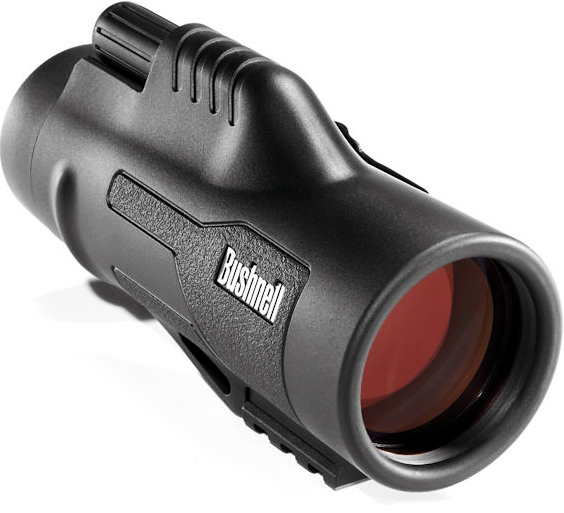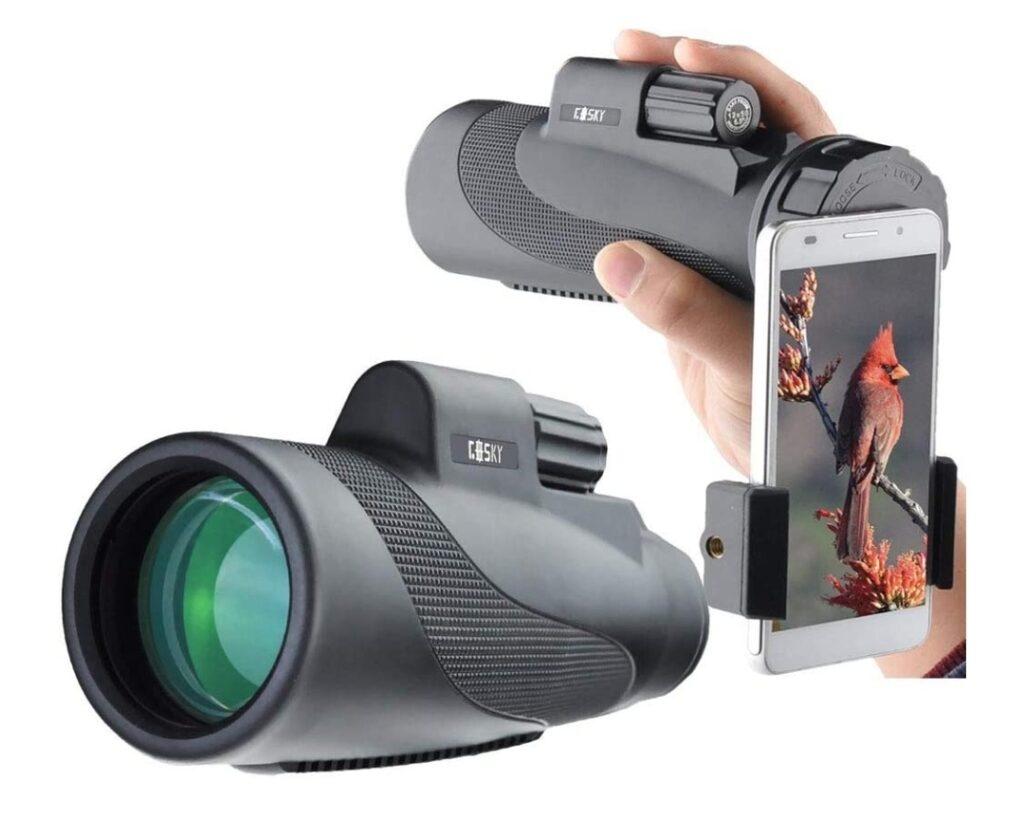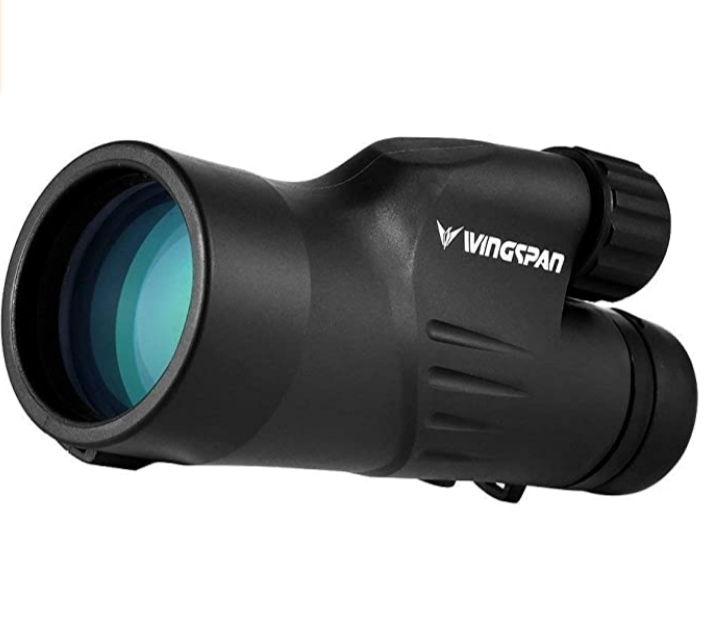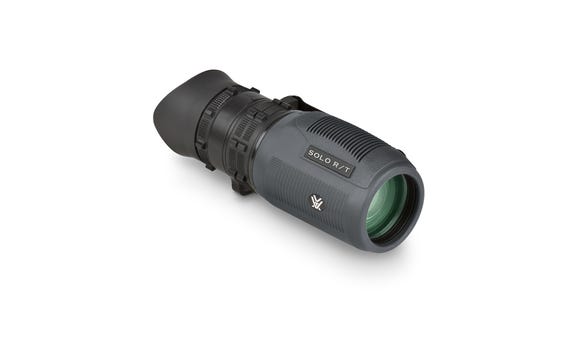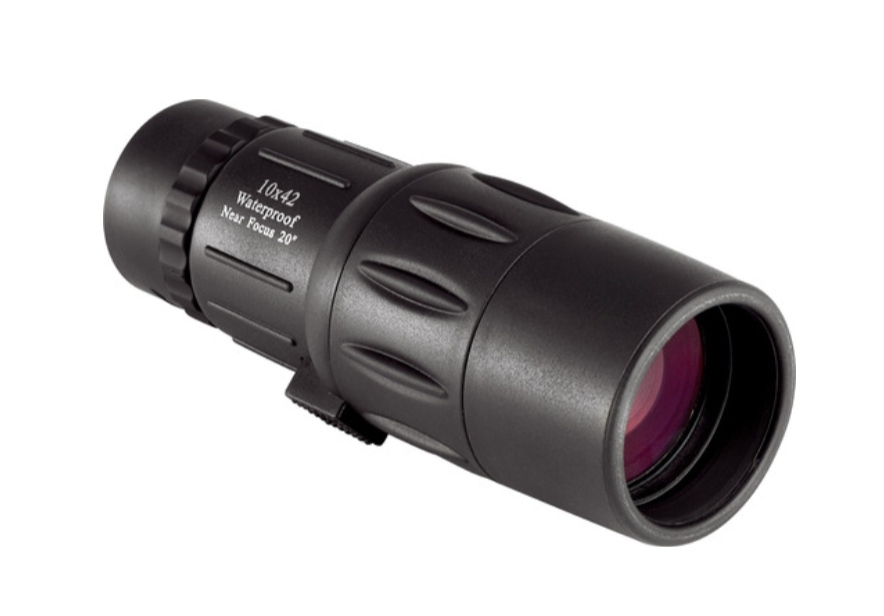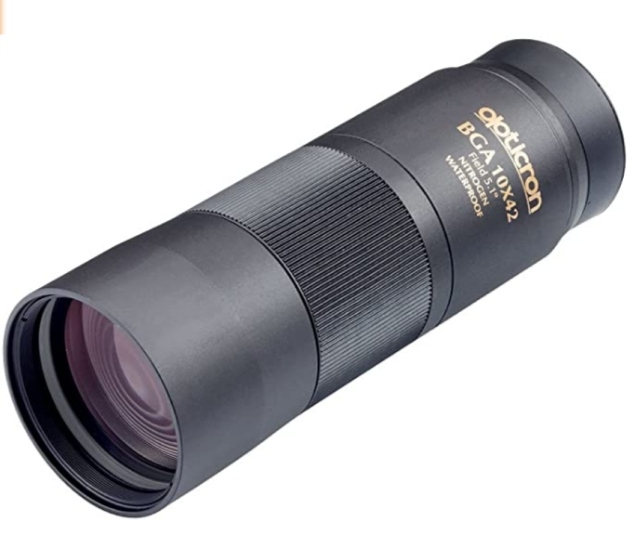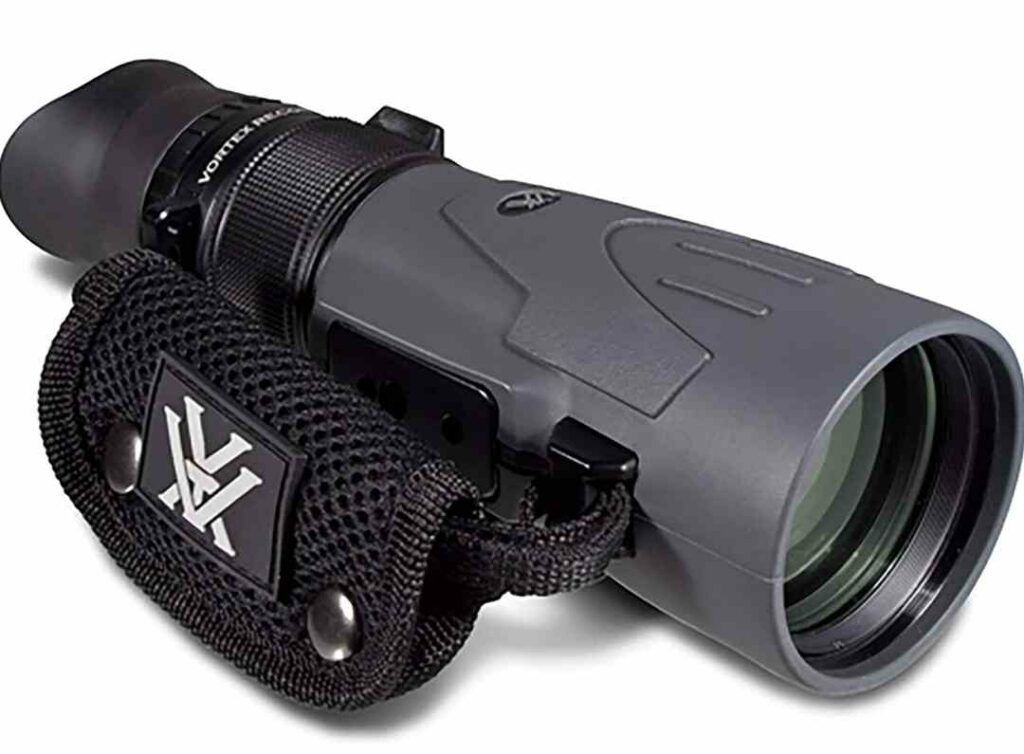*This post may contain affiliate links. This means we may make a commission if you purchase an item using one of our links*
If you’re in the market for a device that’s portable and is versatile enough to be a handheld StarGazing device, you’ve come to the right place.
In this article we will cover the 7 best handheld telescopes that money can buy so that the next time you go on hike and just want to get a better look at wildlife or the night sky, you’ll be able to do so without setting up a whole orchestra…
Okay so let’s get into it.
In A Hurry? Check Out Our Best 3 Picks Below!
Table of Contents





1. Bushnell 191142 Legend Ultra HD Monocular
Pros :
- Waterproof
- Fogproof
- Built really well
- Great light gathering abilities
- Great field of view
- Fully multi coated lens with a bak4 Prism interior
Cons :
- Eye relief is a bit short for glasses users
- The rear dust cap isn’t very stable
- Quite expensive
The Bushnell legend ultra HD is our number one pick and for good reason. This device has great power with its aperture coming in at 10 x 42mm or just over 1.65 inches, which in laymen terms means it will magnify to around 10x but can theoretically also achieve a max magnification of 45x.
When compared to a telescope these numbers are very lackluster however ,for a handheld device this should allow you to see a fair few celestial objects and of course even birds or far away mountains if that’s something you’d want to do.
In regards to the celestial objects you’ll be able to see, this includes the moon, jupiter and its 4 largest moons, saturn and of course the plethora of stars in the night sky.
Not only is the Bushnell compact and well made, considering its surrounded by a solid rubber coating but, its light gathering capabilities as a result of the coating around its lens makes it far better than a lot of cheaper handheld alternatives too.
The glass in this case is made of ED prime glass, PC-3 Phase-Coated prisms and a multi-coating optics technology which will alow you to see crisp and clear images when looking through the eyepiece.
It’s also water proof and fog proof making it quite a useable rugged device. Furthermore, its eye relief isn’t bad either coming in at 15.2mm but some glasses may struggle to get the best out of the bushnell.
One downside that the bushnell may have is its price (for some at least) nevertheless, as a whole it is an excellent monocular device for on the go StarGazing.
==>Click Here To Check The Bushnell 191142 Legend Ultra’s Pricing On Amazon!
2. Gosky Titan 12X55 High Power Prism Monocular
Pros :
- 18 mm eye relief
- Waterproof
- Fogproof
- High magnification
- Very affordable
- Rugged design
Cons:
- Issues with adapter getting loose
- Hard to hold the 12x magnification steady
The Gosky Titan is another great device that has a number of high quality features, such as it’s high powered 12 x 55mm aperture lens, its very active based build from the shock proof design and rugged characteristics being waterproof and fogproof. .
As it is also a bit bigger than the bushnell the portability will suffer ever so slightly however, in all honestly none of the Monocular handhelds on this list will suffer from being too big too handle so to speak.
Although it’s a Bak 4 prism design and the overall ability to capture more light and detail isn’t quite to the Bushnell’s quality, it will still allow you to view a ton of cool celestial objects such as Jupiter and it’s 4 most prominent moons, stargaze at night, birdwatch, watch concerts from afar and so on.
Its eye relief at 18mm also makes it far better for individuals who want to use it whilst wearing glasses, which I can’t say the same for device above
Overall, although the Gosky does not have the most advanced optics on this list, for what it offers at its price, you honestly cannot go wrong with it!
==>Click Here To Check The Gosky Titan 12X55’s Pricing On Amazon!
3. Wingspan Optics Titan High Powered Monocular
Pros :
- Waterproof
- Fogproof
- Solid 12x magnification
- Solid light gathering abilities for dark days
Cons :
- Poor eye relief for users wearing glasses
- Shaky at the high magnification level
- Average field of view
The Wingspan is another higher powered handheld Monocular device with a very solid magnification and aperture of 12 x 50. At this level you’ll be able to view everything that the previous 2 devices mentioned from jupiter and its moons, our moon of course along with birds, mountains in the distance, concerts or sports matches in stadiums among other things.
The wingspan has excellent light gathering abilities as even in pitch black planes you will be able to make out objects around 300 meters away. This is as a result of the optics used within being of the bak 4 porro prism design.
It’s also quite ruggedly built being both waterproof and fog proof whilst, it weighs in at less than 0.4kg so portability will be far from a problem, although it is among the bigger devices on this list so neck strain could be a minor problem.
A few cons the wingspan 12 x 50 has includes its lackluster included tripod, the likely shaky experience you will have with it at its 12x magnification level and finally its quite poor eye relief at 14mm.
Other than those negative points it will still make a great companion for either watching concerts, looking at stars (and a few of the planets in our solar system) along with even scooping out the best places to use a telescope for the best StarGazing experience.
Overall, the Wingspan is a very competent handheld monocular telescope that doesn’t cost an insane amount to buy which will more than get the job done.
==>Click Here To Check The Wingspan Optics Titan’s Pricing On Amazon!
4. Vortex Optics 8×36 Solo R/T Monocular
Pros :
- Dust repellent
- Fogproof
- Waterproof
- Wide field of view
- Very compact and portable
- Great lens coating used
Cons :
- Has focusing issues
- Shaky at high magnification levels
- Mediocre optical size
In terms of capabilities the vortex optics 8 x 36 telescope is the weakest out of the bunch here however, in regards to portability and compactness it trumps all of the other monocular telescope on this list.
With a 36mm aperture and 8x magnification out of the box, you’ll find that the vortex doesn’t have the same light gathering abilities as the devices mentioned above however, it will still be a very competent device for hunting, watching concerts from afar and little bit of StarGazing.
That being said it’s still quite shaky at the maximum magnification level so it may be worth investing in a sturdy tripod.
Other than its not so brilliant light gathering abilities, it does have an eye relief of 18mm making it a great device for individuals who wear glasses and its field of view being 393ft/1000yards makes it quite the versatile device for users wider views of the night sky.
It comes with a great strap on belt and is built for rugged hikes considering its dust resistance, waterproof and fogproof so, even if it’s far from the most powerful on this list, the vortex 8 x 36 will still provide a brilliant experience if you decide to pick it up.
==>Click Here To Check The Vortex Optics 8×36’s Pricing On Amazon!
5. Orion 10×42 Waterproof Monocular
Pros :
- Waterproof
- Rugged rubberised build
- Portable and lightweight
- Great for viewing wildlife like butterflies up close
Cons :
- Inferior Bk7 prism used
- Not dust proof
- No included dustcap to protect the lens
The Orion 10 x 42 is yet another solid handheld device allowing users to see a 10x magnification at its base whilst also providing solid light gathering abilities with its fully coated 42mm aperture lens.
As a result you will be able to see a large variety of things whether it be wildlife really close up or the planets and stars. Its technical capabilities are awesome despite its slightly inferior bk7 Prism optics. Nevertheless, with the Orion 10 x 42 the images seen through eyepiece will be very crisp and clear.
Portability isn’t a problem for a single device on this list and this device is very good in that regards too, although it isn’t necessarily the most compact and lightweight monocular telescopes.
Once again the Orion 10 x 42 is made for an active lifestyle being waterproof and surrounded by a rubberised coating. The strap provided in the box is also for you to keep it safe at all times when not in use.
Last of all, it has a good field of view coming in at 309ft/1000 yards and enough eye relief at 17mm to allow for most users wearing glasses to comfortably look through the lens.
==>Click Here To Check The Orion 10×42’s Pricing On Amazon!
Click Here For Orion’s Official Pricing!
6. Opticron BGA 10×42 Monocular
Pros :
- Waterproof
- Fogproof
- Very compact and portable
- Great for up close views
- Smooth focusing ring
Cons :
- Narrow field of view
- A little expensive
Opticron BGA once again has the middle of the road 10x magnification with a 42mm aperture lens but, this doesn’t mean it’s not a capable device for the occasional StarGazing session.
The optical prism used inside the body of the Opticron is a higher end Bak 4 prism whilst the lens is also fully coated allowing for it to have superior light gathering abilities, particularly in very dimly lit scenarios.
Furthermore, the device will be excellent for not only StarGazing and viewings very distant events or objects but also close shots of wildlife or even a TV screen only a couple meters away.
The image through the opticron is both crisp and clear whilst the eye relief at 16mm just about makes the cut for users who wear glasses.
Like all the devices mentioned previously it’s fogproof and waterproof which means it will survive and be very much usable on a rainy day.
In regards to any negatives, the only major one has to do with its subpar field of view coming in at 267ft/1000y but, other than the Opticron 10 x 42 will be excellent for occasionally looking at stars and planets.
==>Click Here To Check The Opticron BGA’s Pricing On Amazon!
7. Vortex Recon 15×50 R/T Tactical Scope RT155
Pros :
- Top quality optics and lens coating
- Built really sturdily
- Waterproof
- Dust repellent
- Fogproof
- Useable for viewing objects reasonably close (around 3.5m)
Cons :
- Narrow field of view
- A little heavy
- Expensive
Number 7 on this list is arguably the best device however, considering its absurd pricing, it’s also not one I’d recommend the majority of users buy.
That being said the Vortex Recon has the best build quality out of the lot, is waterproof, dust repellent and of course fogproof. It is made out of a ultra hard scratch resistant material with a rubberised grip allowing for top class durability with a sturdy grip.
Furthermore, the Vortex is capable of the most magnification right out of the box at 15x with its fairly sizable 50mm roof prism optics. Vortex’s XR proprietary anti-reflection lens coatings also makes it probably the best device out of the lot for dimly lit environments.
With this device not only will be able to gaze at stars in a fair bit more detail due to its larger magnification but, you will also comfortably be able to observe closer wildlife or landmarks too.
In terms of comfort the lens cap design is wing shaped whilst the eye relief at 16mm should allow just about enough room for users wearing glasses to get a good view.
One of its downsides has to be the narrow field of viewing, which in this case is 215ft/1000y whilst its larger size and weight will make it a bit more of nuisance to carry around your neck when on an outing.
As a whole though, the Vortex Recon does provide the best optics out of all the monocular devices on the list but, at a much heftier asking price so, in the end of the day you’ve got to ask yourself whether the slightly better optics is worth the exponential hike in price. If the is yes here then the vortex Recon is almost a no brainer in my opinion
==>Click Here To Check The Vortex Recon 15×50’s Pricing On Amazon!
Different Types Of Monocular Telescopes
The optics inside a monocular device can come in 3 main variations so, in this part of the list I’ll briefly breakdown the each variation so you cam understand how the optics work just a little bit more.
Galilean
This design utilises a built in lens which would make your monocular telescope far better for close up views of objects however, this also isn’t that great a design for stargazing which is why no device on this list incorporates the Galilean design
Porro Prism
The Porro Prism based design is at this current moment an inferior prism design as a result of the more modern roof prism optics.
Nevertheless, a good amount of monocular devices still use them. The type of Porro prism optics can be split into 2 different variants with devices using high density glass being the Bak-4 prism and secondly the Bk-7 prism which uses what can be referred to as crown glass with shaded edges.
Although the Bak-4 and Bk-7 designs are somewhat obsolete, the overall image quality they produce is still very good.
Roof Prism
This is the most modern and also the most complicated prism design that is currently used. Due to its intricate and more expensive optical design it does produce the best overall results out of the 3 main monocular optics.
Which is why if you’re willing to pay the extra money, although it isn’t absolutely necessary for stargazing, roof prism monoculars should in theory provide the best results even if they’re just marginally the better than porro prism optics.
What Does The Size Of The Monocular Telescopes Objective Lens Signify?
The size of the objective lens found on any handheld monocular telescope simply signifies the devices ability to gather light so, in turn the bigger the objective lens the more detail you’ll be able to make out with your device. Low light performance will be better too. Of course multi-coatings also help with contrast levels as well.
With that being said, a larger objective lens does result in the monocular device being bigger and ultimately heavier so, ideally you’d want to balance the size of the lens with how comfortable it will be to carry the handheld telescope around your neck (with the strap that is).
The Field Of View
The field of view that a monocular device displays will generally be determined by what you want your handheld to do specifically. Generally speaking if you decide to go for a device with more magnification (which should be the route to go for planetary observation) the field of view will be narrower.
And in turn lower magnification level handheld telescopes tend to have the far wider field of view, which will be good at simply stargazing but it will be difficult for such a device to be all that effective at observing planets like jupiter for example.
If you do want to be able to observe planets in more detail though, this list going over our best telescopes picks may be worth looking into.
Conclusion
Hopefully this article has helped you find a handheld scope that fits your needs and will result in a far better StarGazing session the next time you go out!
If there is anything you’d like for us to cover, feel free to leave a comment for us down below and we will do our best to look into it for you!
A Recap Of Our 3 Favourites!







